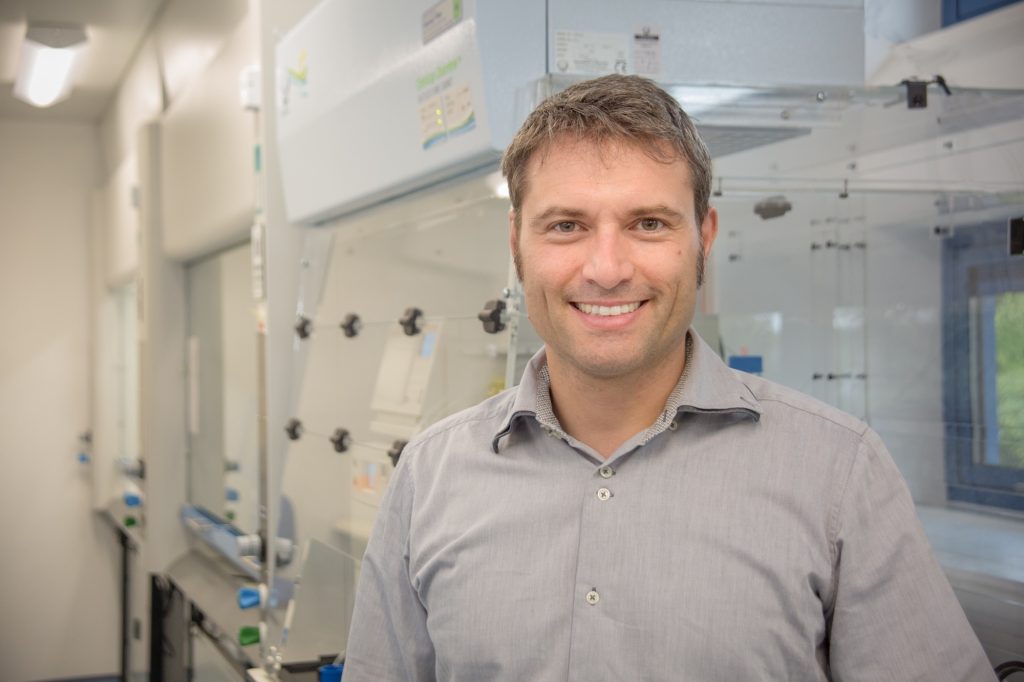
Last year a new translational research centre was established to bolster the University of Dundee’s drug discovery position. The Centre for Targeted Protein Degradation (CeTPD) would allow Professor Alessio Ciulli and colleagues to expand their pioneering work in an area that has attracted billions of pounds of investment. Lu Rahman finds out more.
Targeted protein degradation co-opts the cell’s natural disposal systems to remove disease-causing proteins and is applicable to diverse therapeutic areas including oncology, dermatology, immunology, neurodegeneration and respiratory diseases. As an entirely new approach, it provides hope of treating diseases previously thought to be undruggable. The first degrader drugs of these kind are advancing in clinical trials against cancer.
Professor Ciulli has revealed fundamental insights into the working of the degrader molecules that he designed and that are used across the globe. These and other discoveries have led to collaborations with some of the world’s largest pharmaceutical companies. Amphista Therapeutics, the university spin out he founded, received a near-£40 million investment to further its work developing new drugs for a range of diseases in March 2021.
“Targeted protein degradation is one of the most exciting areas of scientific study to have emerged in many years, one which is revolutionising drug development,” says Ciulli. “We are only beginning to explore the true potential of TPD to produce next-generation therapeutics for a variety of diseases. Our new home will provide opportunities for growth and to capitalise on the expertise we have established here. It will help to accelerate innovation and will also attract further investment and major collaboration partners in the pharmaceutical industry.”
The CeTPD is expected to contribute to a pipeline of spin-out companies translating exceptional fundamental research into products that benefit patients across the world and underpin commercial entities.
Professor Ciulli is the Chair of Chemical Structural Biology at the University of Dundee and the Founder and Director of Dundee’s new Centre for Targeted Protein Degradation (CeTPD).
He has made fundamental contributions to the development of the PROTAC field, and is the scientific founder of Amphista Therapeutics, a University of Dundee spin-out company that develops novel medicines through targeted protein degradation based on his technology. He has won numerous prizes and awards and is a Fellow of the Royal Society of Chemistry.
The Ciulli Lab focuses on the design and application of small molecules targeting protein interactions and protein degradation.
“Targeted protein degradation is an exciting new modality of drug discovery,” says Ciulli. “Whereas conventional drugs only temporarily block or inhibit disease causing proteins by binding to their most important functional parts, targeted protein degraders can bind at many positions to specifically remove disease-causing proteins by ensuring their destruction. They work by harnessing the cell’s natural disposal system (the ubiquitin-proteasome). Candidate disease-causing proteins are labelled as ‘expire” proteins which the proteasome then shreds,”1 he adds.
This revolutionary mode of action allows targeted protein degraders to attack targets previously thought ‘undruggable’ ie. that have failed traditional medicinal chemistry approaches. It constitutes a platform technology applicable across diverse disease areas.
“Among the most popular types of small molecules degraders are proteolysis-targeting chimeras (PROTACs). A PROTAC is designed as a two-headed molecule where one end binds an enzyme (an E3 ligase) and the other binds the disease protein, bringing the two into close proximity. The ligase can then label the disease protein for degradation by the cell’s disposal system,” says Ciulli.
Professor Ciulli is one of the pioneers of the development of PROTACs. Using structure-guided fragment-based design, the Ciulli laboratory, initially in collaboration with the laboratory of Craig Crews (Yale University), designed and developed drug-like small molecule ligands that bind with high affinity and specificity to the E3 ligase von Hippel-Lindau (VHL)2. The VHL ligands developed by Ciulli and colleagues are one of two most widely used E3 ligase ligands for PROTAC development. Ciulli later designed second-generation ligands with improved binding affinity and drug-like properties, producing VHL inhibitor VH298 as a new chemical probe3.
In 2015, Ciulli developed one of the very first ever non-peptidic two-headed PROTAC approaches by connecting his VHL ligands to a molecule that targets and binds to the BET (Bromodomain and Extra-Terminal motif) proteins that are critical for cancer cell growth and survival. This breakthrough cell-penetrant PROTAC, called MZ1, showed rapid, potent, and reversible degradation of BET proteins in cancer cells, offering unprecedented advantages over conventional inhibitors4. This discovery, together with three other papers published at the same time, collectively marked the beginning of a new era for targeted protein degradation.
Importantly, Ciulli observed that MZ1 induced preferential degradation of one BET protein (called BRD4) over its homologs BRD2 and BRD3 within cells5. “This was unexpected because MZ1 engages all BET proteins with comparable binding affinity. It offered the first report of PROTAC-enhanced selectivity over conventional inhibitors, a phenomenon now widely observed in the field,” he says.
Ciulli hypothesised that the specificity of a PROTAC might be influenced by the structure and interactions within each three-part complex of ligase-PROTAC-target and, in 2017, his laboratory solved the first crystal structure of such a complex6. This major breakthrough gave the new field the first ever glimpse of how a PROTAC brings the E3 ligase and its target protein together, within the crucial “ternary complex”. Using this knowledge and the crystal structure to guide design, the Ciulli group produced a new PROTAC that had improved selectivity at depleting BRD47. More recently, he has shown that the BRD4:MZ1:VHL is a long-lived complex, and its slow dissociation drives faster degradation rates for Brd48. Together these studies elucidate previously under-appreciated structural and mechanistic insights of how PROTACs work, providing guiding design principles.
Beyond targeting BRD4, the Ciulli Lab has developed PROTACs for the E3 ligases VHL, in a first report of the “Homo-PROTAC” approach9 and CRBN10 and the chromatin remodeler complex subunits Brd7/911 and SMARCA2/412 These emerging cancer targets were previously considered “undruggable”.
Ciulli has also developed innovative and elegant chemistry for PROTAC design, including novel fluoro-hydroxyprolines for VHL ligands13, macrocyclic PROTACs14 and trivalent PROTACs15.
In summary, Ciulli’s research has helped to transform a niche area of chemical biology into one of the most exciting new fields of drug discovery. An expert opinion piece in Nature16 cites his publications and work of two other groups as achieving the spectacular leap in performance that enabled PROTAC technology, which had not gained traction in a decade, to become the focus of a “gold rush”.
“The new Centre at Dundee will play a pivotal part in allowing this research to reach scale, accelerate the next generation of academic innovation in this area, and expand translation in new therapeutic areas,” explains Ciulli. “To achieve this, it will catalyse the development of new methods, and new technologies to accelerate protein degradation research, making these available to the community via publications and open-access sharing.”
Ciulli adds that the vision is for the centre to be a pinnacle for training and innovation in the field. “It will offer a supporting and creative environment to train the next generation of students, researchers and scientific leaders in a highly sought-after area of modern chemical biology and drug discovery, and empower them with the tools and freedom to innovate and break ground.”
Ciulli’s insights reveal more about the working of the degrader molecules that he has been instrumental in designing and that are used across the globe. These and other discoveries have led to significant collaborations with some of the world’s largest pharmaceutical companies.
“By 2019, PROTACs were ‘driving billions of US dollars in investment from pharmaceutical companies such as Roche, Pfizer, Merck, Novartis and GlaxoSmithKline’. A 2020 global market report by Roots Analysis indicates over $3.5billion investment in targeted protein degrader drugs since 2014, with PROTACs accounting for over 30% of pipeline drugs in this class,” he says. “These research advances and investments directly resulted in a first wave of PROTAC drugs entering clinical trials.”
Today, over six PROTACs are in expedited Phase I/II clinical trials for several diseases, including refractory metastatic castration-resistant prostate cancer (>250,000 new patients a year in the USA alone) and metastatic breast cancer (half a million global deaths annually), respectively17.
Ciulli’s world-leading publications in this new area generated enormous interest from investors and pharmaceutical companies. In July 2016 Boehringer Ingelheim (BI) announced a significant (non-disclosed) investment in a collaboration with Ciulli to develop new classes of therapeutics based on PROTAC technology. The partnership, first extended in 2018 and more recently in July 2021 represents a first in terms of size, scope and longevity for academic-industry collaboration. With an initial focus on oncology, the team based at CeTPD and led by Dr William Farnaby progresses PROTACs against human cancer targets.
Since striking his major deal with Boehringer Ingelheim, Ciulli’s research has continued to attract interest leading to significant collective investment into Dundee from other pharmaceutical companies including Nurix, Ono Pharma, Eisai, Merck and Almirall.
“Collaborating with the pharmaceutical industry is critical to fast-track and accelerate the development of technologies or modalities, first innovated within academia, such as PROTACs, into assets and molecules with real-world impact, such as investigational medicines,” says Ciulli. “Our new model offered by Dundee’s CeTPD invokes the creation and build-up of highly collaborative open joint teams, across the two sites, that work together to progress project forward and develop high-quality small molecules with the potential to save patients’ lives.”
Volume 23, Issue 1 – Winter 2021/22

About the author
Professor Alessio Ciulli is the Chair of Chemical Structural Biology at the University of Dundee and the Founder and Director of Dundee’s new Centre for Targeted Protein Degradation (CeTPD). He obtained his M.Sc. (University of Florence) and Ph.D. degrees (University of Cambridge) in Chemistry, followed by post-doctoral research at Cambridge and a visiting fellowship at Yale University. He has made fundamental contributions to the development of the PROTAC field, and is the scientific founder of Amphista Therapeutics.
References
- Ciulli & Trainor, The Biochemist 2021
- Buckley, J Am Chem Soc 2012; Galdeano, J Med Chem 2014
- Frost, Nat Commun 2016 ; Soares, J Med Chem 2018
- Zengerle, ACS Chem Biol 2015
- Gadd, Nat Chem Biol 2017
- Roy, ACS Chem Biol 2019
- Maniaci, Nat Commun 2017
- Girardini, Bioorg Chem 2019
- Zoppi, J Med Chem 2019
- Farnaby, Nat Chem Biol 2019
- Testa, J Am Chem Soc 2018
- Testa, Angew Chem Intl Ed 2020
- Imaide, Nat Chem Biol 2021
- Scudellari Nature 2019
- Mullard Nat Rev Drug Discov 2021